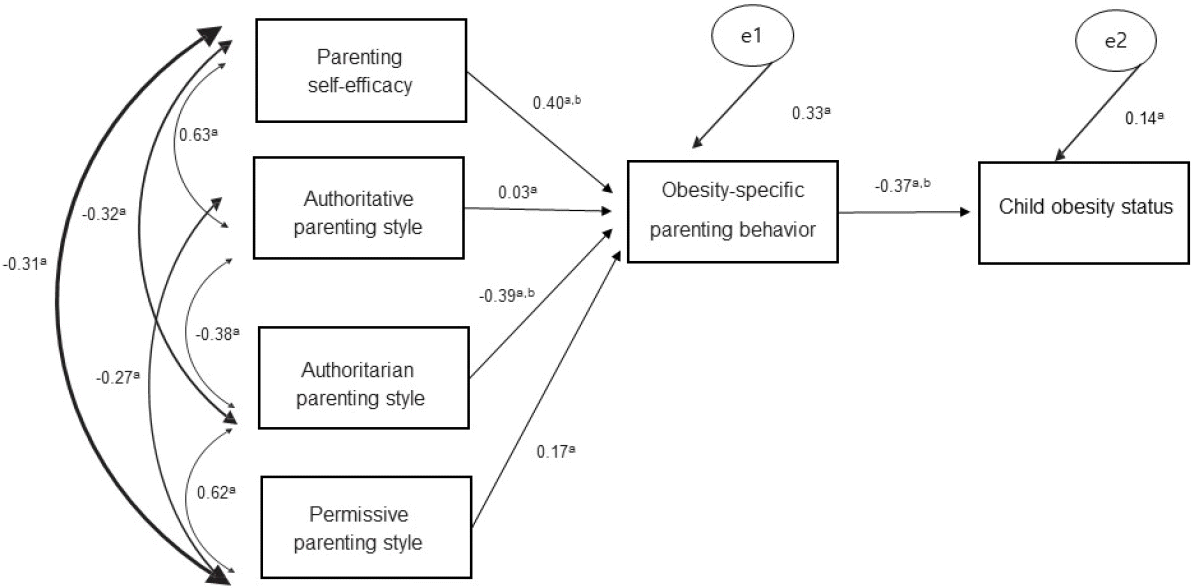1. Lobstein T, Jackson-Leach R, Moodie ML, Hall KD, Gortmaker SL, Swinburn BA, et al. Child and adolescent obesity: part of a bigger picture. Lancet. 2015; 385(9986):2510–20.

3. Wang Y, Lim H. The global childhood obesity epidemic and the association between socio-economic status and childhood obesity. Int Rev Psychiatry. 2012; 24(3):176–88.

5. Gurnani M, Birken C, Hamilton J. Childhood obesity: causes, consequences, and management. Pediatr Clin North Am. 2015; 62(4):821–40.
6. Llewellyn A, Simmonds M, Owen CG, Woolacott N. Childhood obesity as a predictor of morbidity in adulthood: a systematic review and meta-analysis. Obes Rev. 2016; 17(1):56–67.

7. Sleddens EF, Gerards SM, Thijs C, de Vries NK, Kremers SP. General parenting, childhood overweight and obesity-inducing behaviors: a review. Int J Pediatr Obes. 2011; 6(2-2):e12–27.

8. Karp SM, Barry KM, Gesell SB, Po’e EK, Dietrich MS, Barkin SL. Parental feeding patterns and child weight status for Latino preschoolers. Obes Res Clin Pract. 2014; 8(1):e88–97.

9. Grossklaus H, Marvicsin D. Parenting efficacy and its relationship to the prevention of childhood obesity. Pediatr Nurs. 2014; 40(2):69–86.
10. Morawska A, West F. Do parents of obese children use ineffective parenting strategies? J Child Health Care. 2013; 17(4):375–86.

11. Ling J, B Robbins L, Hines-Martin V. Perceived parental barriers to and strategies for supporting physical activity and healthy eating among head start children. J Community Health. 2016; 41(3):593–602.

12. Bandura A. Health promotion by social cognitive means. Health Educ Behav. 2004; 31(2):143–64.

13. Sanders MR. Triple P-positive parenting program as a public health approach to strengthening parenting. J Fam Psychol. 2008; 22(4):506–17.

14. Gerards SM, Kremers SP. The role of food parenting skills and the home food environment in children’s weight gain and obesity. Curr Obes Rep. 2015; 4(1):30–6.

15. Baumrind D. Current patterns of parental authority. Dev Psychol. 1972; 4(1p2):1.

16. Hubbs-Tait L, Kennedy TS, Page MC, Topham GL, Harrist AW. Parental feeding practices predict authoritative, authoritarian, and permissive parenting styles. J Am Diet Assoc. 2008; 108(7):1154–61.

17. Choo J, Yang HM, Jae SY, Kim HJ, You J, Lee J. Effects of the healthy children, healthy families, healthy communities program for obesity prevention among vulnerable children: a cluster-randomized controlled trial. Int J Environ Res Public Health. 2020; 17(8):2895.

18. Kline RB. Structural equation modeling. 1st ed. New York: Guilford;1998. p. 171–207.
20. World Health Organization. Growth reference data for 5-19 years [Internet]. Geneva: World Health Organization;2007. [cited Nov 2, 2018]. Available from:
http://www.who.int/growthref/tools/en/.
21. Dumka LE, Stoerzinger HD, Jackson KM, Roosa MW. Examination of the cross-cultural and cross-language equivalence of the parenting self-agency measure. Fam Relat. 1996; 216–22.

22. Robinson CC, Mandleco B, Olsen SF, Hart CH. The parenting styles and dimensions questionnaire (PSQD). 1st ed. California: Sage;2001. p. 319–21.
23. Birch LL, Fisher JO, Grimm-Thomas K, Markey CN, Sawyer R, Johnson SL. Confirmatory factor analysis of the child feeding questionnaire: a measure of parental attitudes, beliefs and practices about child feeding and obesity proneness. Appetite. 2001; 36(3):201–10.

24. Shelton D, Le Gros K, Norton L, Stanton-Cook S, Morgan J, Masterman P. Randomised controlled trial: a parent-based group education programme for overweight children. J Paediatr Child Health. 2007; 43(12):799–805.

25. Shumow L, Lomax R. Parental efficacy: predictor of parenting behavior and adolescent outcomes. Parent Sci Pract. 2002; 2(2):127–50.

26. Collins C, Duncanson K, Burrows T. A systematic review investigating associations between parenting style and child feeding behaviours. J Hum Nutr Diet. 2014; 27(6):557–68.

27. Vollmer RL, Mobley AR. Relationship between parental feeding and child eating styles in low‐income families with preschool age children. FASEB Bioadv. 2013; 27(1):37.

28. Bornstein MH, Bradley RH. Socioeconomic status, parenting, and child development. 1st ed. New York: Routledge;2002. p. 304.
29. Hoff E, Laursen B. Socioeconomic status and parenting. . 3rd ed. New York: Routledge;2019. p. 421–47.
30. West F, Sanders MR, Cleghorn GJ, Davies PS. Randomised clinical trial of a family-based lifestyle intervention for childhood obesity involving parents as the exclusive agents of change. Behav Res Ther. 2010; 48(12):1170–9.






 PDF
PDF Citation
Citation Print
Print



 XML Download
XML Download